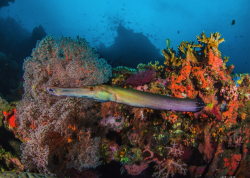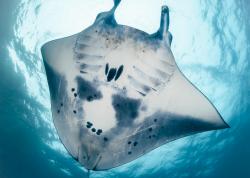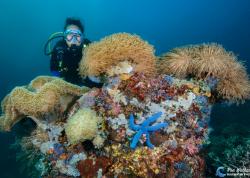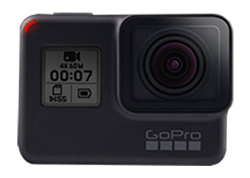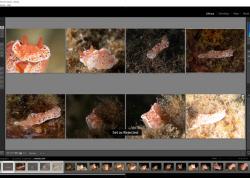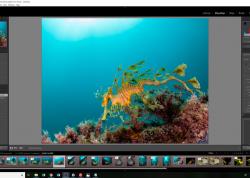Diving Tulamben, Bali: Macro, Wide and Wreck!
Tulamben, Bali is one of my favourite dive destinations. Sure, places like the Galapagos and Fakarava may be more flashy, with their multitudes of sharks and other big animals, but Tulamben holds a very near and dear place in my heart. For starters, the muck diving is incredible, with each muck dive a unique treasure hunt where you never know what you’re going to find. Add to that some excellent wide angle sites, with beautiful reefs, sea fans, jellyfish and turtles. And on top of that, one of the most famous wreck dives in the world, the USAT Liberty!
.jpg)
Dive Sites
Tulamben is on the northeast coast of Bali, about a 3-4 hour drive from Ngurah Rai International Airport. Yes, it can be a bit of a slog, but it doesn’t have to be! Bali is an amazing island covered in beautiful scenery, and it is not particularly expensive to hire a local driver/guide. Then you can make a day trip out of it and stop at a few nice places along the way, or if you have time, spend some time in the lovely town of Ubud. My partner Lisa and I spent a lot of time on Bali, so we were able to do a week-long yoga/meditation retreat (phenomenal), stay at a lovely Airbnb in Ubud for a week, dive with mantas in Nusa Penida for a few days, and dive Tulamben for 12 days.

We stayed at the nicest dive resort I have ever been to – Villa Markisa. One of the things that makes diving Tulamben so much fun is how incredibly close the dive sites are. First off, the famous Seraya Secrets is the house reef, so it’s a simple shore dive…just gear up and walk right in! The USAT Liberty is less than 10 minutes by boat, and a multitude of muck and reef dives are all less than 10 minutes by boat. Some are so close that the boat only just makes it to full speed before you are already slowing down and approaching the dive site. This is the only dive resort I have ever been to where the dive sites are comparably close to if you were diving from a liveaboard. The only exceptions are the Amed dive sites, which are about 30 minutes by boat…but that is really not bad at all.
This means that after each dive (except for Amed), you return to the resort for some time to dry off, lounge around, and swap your camera battery (especially if you’ve been trying to shoot something tiny like a Shaun the Sheep nudi).
.jpg)
A small Eubranchus ocellatus nudibranch. Olympus OM-D E-M1, Nauticam housing, Olympus 60mm macro lens, +7 diopter, 2x YS-D1 strobes. f/16, 1/320 sec, ISO 200.
Muck Diving
Every day I really looked forward to our muck dives. I would ask our guide, Edi, about critters I wanted to see, and he would see what he could find.
If you have not done muck diving before, it may sound the opposite of fun. Who wants to gear up and then roll around in mucky mud for an hour? In fact, muck diving is quite different from what it sounds like – it typically refers to diving on a sandy bottom of some description, looking for all kinds of assorted little weirdos.
.jpg)
A typical muck dive involved an easy back-roll into flat, calm, bathwater temperature water, followed by a short descent down to the top of a sandy slope. Then we’d work our way down the slope, zig-zagging across the sand and visiting a dizzying variety of small “outposts”, little islands of life centered around hydroids, whip corals, anemones, crinoids, sea pens, rocks, or any other break in the sand. Each of these little oases of life had potential to contain any number of perfectly adapted commensal shrimps or crabs, as well as cuttlefish, nudibranchs, fish, and other neat critters.
Our guide Edi would swim on ahead, marking every cool critter with a bamboo stake, and leaving us a treasure trail to follow. After looking at a subject, I would either spend some time photographing it, or decide to move on, and just picked up the stakes as I went. Lisa spent less time on each subject, getting lots of cool macro video with her GoPro 7 macro setup.
.jpg)
Though it was not only these strange oases that held life; the sand itself had its share of strange and wonderful denizens, all carefully adapted for life in this challenging environment.
.jpg)
Whip corals always look kind of strange, but especially so when popping up out of the muck. They are typically worth a second look, as most of them have one or more shrimps or gobies on them, camouflaged remarkably well, and typically quite good at moving to the opposite side of the coral from where you put your camera!
.jpg)
Night dives brought out more cephalopods and shy crustaceans like the adorably cute boxer, or pom-pom crab, bobtail squid, and lots of cuttlefish.
.jpg)
Surprise!
Many muck dives we were treated to some very high value, exciting surprises. You really never know what you’ll find, though it is fair to expect something cool will show up at some point. Especially when you have a guide as sharp as Edi!
As one of our dives was ending and we were doing our safety stop, Edi came ripping over to grab me, and took me to two harlequin shrimp, perched on a rock with a starfish arm! Fortunately I still had enough air in the tank to get some nice shots.
.jpg)
Another dive I was so busy photographing a nudibranch that I missed a lot of commotion from Edi and Lisa, as they tried to get my attention while they watched a flounder try to eat a Mototi octopus, with the Mototi hitching a ride on the flounder! Fortunately, they were able to get my attention after the drama, and I got to spend some quality time with the Mototi as it perched on a rock.
.jpg)
Don’t Forget Your Diopter
There are a lot of tiny critters in Tulamben, and many of them are really cool. It is the perfect place to learn how to use a diopter, as many of the critters don’t move too quickly, and they are often found in shallow, warm spots where you can just lie on the sand and take your time getting things in focus and composing your shot.
I asked Edi to see some Shaun the Sheep nudis, and after a 5 minute boat ride and a 5 minute search, he started putting me on them; they looked liked tiny white specks crawling around on small pieces of seaweed. I spent most of my dive working on composition and focus to get a nice shot, as they are extremely small (grain of rice and smaller)!
.jpg)
Costasiella kuroshimae “Shaun the Sheep” nudibranchs. Olympus OM-D E-M1, Nauticam housing, Olympus 60mm macro lens, +7 diopter, 2x YS-D1 strobes. f/22, 1/320 sec, ISO 200.
Then I heard one of the guides mentioning ladybug amphipods, which I had thought were only found in Komodo. It turns out, Emerald dive site had a number of soft corals around the 80-90’ depth which were veritable ladybug amphipod colonies, so I got to spend my 20 minutes of no deco time peering into their micro world, and then returned back for a second go at it later in the week!
.jpg)
A few tips I do have if shooting super-macro for the first time:
- Don’t shoot at minimum aperture (f/22 for the Oly 60 mm) as you will suffer image softness due to lens diffraction. (For dSLR macro lenses this typically kicks in past the f/29 range.)
- It’s worth the extra money to get a very sharp diopter
- Use back-button focus, lock your focus on something high contrast like sand or rocks, and then rock your camera back and forth on your subject until you get the key points (eyes, rhinophores) in focus
If you are looking for your first diopter to try, I would highly recommend the Nauticam CMC-2 for compact and mirrorless shooters (See: Nauticam SMC for dSLR shooters), a very sharp and very compact lens with a 2.8x magnification when used with the Olympus 60mm macro lens. For something stronger, the Nauticam CMC-1 is excellent (4.5x magnification), but it is harder to use than the CMC-2 since it creates a razor thin depth of field.
These images were taken with a +7 diopter, but Nauticam rates their diopter strength differently. I have been told the CMC-1 is approximately equivalent to +15, which makes the CMC-2 around the +8 or +9 range…that should be close, though not exact!
Nudibranch Central!
There is a ridiculous variety of nudibranchs in the area. Villa Markisa did a nudibranch workshop and over one week, the participants photographed something like 550 different species of nudibranch! The only catch is that many of them are absolutely tiny – we are talking 5-10 mm in length, or even smaller (remember: bring a diopter!).
.jpg)
.jpg)
Reef Diving – Wide Angle Time!
Although macro critters are the focus in Tulamben, the wide angle shooting opportunities should not be overlooked. Some of my favourite wide angle shots I have ever taken were in Tulamben. Soft coral dressed the rocks of Emerald in beautiful colors, while huge sea fans adorned the steep walls of Dropoff.
.jpg)
Large jellyfish floated by in the blue, making beautiful subjects with the bright overhead sun.
.jpg)
We dove the reef sites multiple times on our visit, because they were just really nice. Sometimes we saw schools of fish, as well as hawksbill turtles and jellyfish, but even without those big subjects, the reefs themselves were just beautiful. The blue water, lots of nice sunny days, low amounts of other divers, and low amounts of current meant that these sites were perfect for creating beautiful reef scenes, with Edi doing a great job as a very patient dive model.
Amed
Sea fans were everywhere, and out by Amed they were especially plentiful and located in relatively shallow and clear water. This allowed for some very nice compositions with the bright sun.
.jpg)
The pyramids dive site by Amed is an area with a bunch of sunken concrete pyramid structures. Over time they have accumulated a lot of life; large, vibrant reefs rearing up out of the sandy bottom. There were some great wide angle scenes, just bursting with life.
.jpg)
Reef Macro
But wait! There were also awesome macro opportunities awaiting on the reefs. Along with ladybugs at Emerald, we found a pygmy seahorse on a sea fan in the Amed area, which was a very exciting find.
.jpg)
Then, on one of the final dives of the trip, I saw Edi getting very animated and vigorously gesturing us over. We swam over quickly and saw him pointing to a peacock mantis shrimp that was just scuttling through an underpass in the coral. Not sure quite what the fuss was about, as we had seen a lot of peacock mantis shrimp already, we went around to the other side of the reef. As we came around the corner, we quickly saw what was so special – she was a mother and was carrying a lot of eggs! Wow!
.jpg)
USAT Liberty
The world famous USAT liberty shipwreck is less than 10 minutes from Villa Markisa by speedboat. They typically run their Liberty dives at 6 am, meaning you get in the water with the first groups as the sun is just starting to rise. It is an early morning, but it is also nice to be one of the first groups on the wreck. As a bonus, morning is the best time to see the famous (and very large) bumphead parrotfish, which were hanging around the bow when we saw them.
Of course, lighting conditions are challenging at this time, though at least things had brightened up decently by the time we reached the very cool cargo bay.
.jpg)
Although the early morning dive was nice, and I would recommend people try it out, we decided to go back around 8:15 am to try to get better lighting conditions. Overall the crowds were not a whole lot worse, the lighting was better, and we were still there ahead of the madhouse that is the USAT liberty once all of the day trippers arrive a bit later in the day.
.jpg)
Bonus Video
We made a promo video for Villa Markisa using footage from our stay. It has some of our favourite underwater footage, including a bunch of macro video shot with Lisa’s GoPro and my Olympus E-M1. You can check that out here:
When to Dive Tulamben
The good news is that Tulamben diving is good all year ‘round. Unlike Southern Bali, the water temperatures stay nice and warm throughout the year. Bali’s dry season is high season/peak tourist time, and that runs from approximately May to October, with tourist levels peaking July - September. Wet season runs from November to April, though often that consists of rain in the late afternoon, evening or at night, and can still have nice sunny periods during the day.
Of course it is hard to predict exactly. Rainy season will lead to more runoff, lowering visibility, but it also means things are less busy. If you are shooting lots of wide angle, then this may be a detriment, but for muck/macro diving, it really isn’t an issue.
We were there in April, which is shoulder season, and the timing was perfect for us. We still had some rain, especially at night, but most days were bright and sunny, or at least had periods of nice sunshine. The water was calm and warm, and since it was shoulder season, there were less tourists around. October and November, after peak tourist season winds down on Bali, is probably also a nice, quieter time. Even with the rain we had at night, the visibility at the wide angle sites was quite nice, and certainly allowed for some great wide angle shooting.
.jpg)
Who Should Dive Tulamben
Anyone who likes diving! A few of the muck dives we had some currents, but much of the diving was very easy – nice vis, low or no current, warm water, easy navigation. It is perfect for beginners but also has enough to keep very experienced photographers and divers occupied. For people who don’t like to do too much diving per day, there is not much else to do in the area, but you can hire a driver or join a tour to see some of Bali’s beautiful sites, including waterfalls, temples and rice paddies. Or you can just relax in a sunchair, hang out in the pool and have a massage…that doesn’t sound too bad either...
Whether you like wide angle or macro, Tulamben has lots of both. The only thing really missing is sharks and big creatures (for big creatures, see: Nusa Penida) – yes, there can be big pelagics at the Liberty, but all we saw was the bumphead parrotfish and a big grouper or two.
.jpg)
How to Dive Tulamben
There are lots of options for diving Tulamben, with good choices for every budget. Tulamben can be dived as a day trip from Ubud, Denpasar or any other center on Bali, but it does make for a long day, with 3-4 hours of driving in each direction. That probably works if you just want to dive the USAT Liberty once or twice, and don’t mind diving it in a big cloud of divers and bubbles. But if you really want to see what Tulamben has to offer, it’s worth staying in the area, either Tulamben or Amed, so you can dive in the morning before the crowds arrive, and the afternoon/evening once they depart.
For people on a tight budget, you can dive quite cheaply by staying at budget accommodations, using lower cost local shops, local boats and finding the lower priced dive options, or renting your own gear. We have two articles on the UWPG with more information about diving Tulamben on a budget.
Be careful though, as I have heard from some people who did not enjoy diving at Tulamben at all because they did everything as a shore dive, and really did not like trudging through the sharp volcanic sand in all their gear, filling their boots and cutting their feet as they got into the water. And although it may be cheaper to stay somewhere further away and transport back and forth with all your gear in the back of a truck, or on a scooter (!), all of that adds to the exhaustion and tiredness that comes with gearing up and diving in a hot climate like Bali’s.
.jpg)
So it all depends on what you want to get out of the trip. If you really want to see all of the great macro critters, you want to dive in small groups and have lots of time with your subjects, and you want to be able to comfortably do 3-4 dives per day without getting exhausted, then you should really think about a high end resort like Villa Markisa.
Every dive we did was an easy boat dive (except for Seraya Secrets, which was a < 50 ft walk directly from the dive center into the water). Our dive guide ratio was typically 1 guide for the just the two of us, though sometimes we had a third person join us. We were given the same guide for our whole visit, which meant he got to know exactly how we dived and what we wanted to see, and tuned up his dive plans and critter finding just for us. And I know that if we had dived on our own, we would have only seen maybe 15% of what he showed us.
The ease and convenience of the waterfront setup meant that we avoided spending long amounts of time in transit, especially over land, and had lots of energy to dive 3-4 times per day. It was basically like diving from a liveaboard, except we had a really nice resort on land, with lots of space and areas to relax, and no risk of getting seasick.
I loved diving Bali so much that I set up a photo workshop with Bluewater to go back there in September 2020! We will be staying 4 nights in Tulamben for macro, reefs and the Liberty, and then spending 4 nights in Nusa Penida for mantas and molas, with daily photo workshops and hands-on instruction and help. You can check that out below - click on the link for more details!
Bali Photo workshop SEPT 23 - OCT 1, 2020
Led by Bryan Chu
SEPTEMBER 23 - 27 AT VILLA MARKISA
SEPTEMBER 28 - OCTOBER 1 AT HAI TIDE BEACH RESORT
8 Nights at the two venues for:
Basic Room - $2,031 per person
Deluxe Room - $2,299 per person
Bungalow/Sonea - $2,398 per person
Master Bedroom - $2,468 per person
Our sister company, Bluewater Travel was named one of the Best Dive Travel Agencies in Scuba Diving Magazine's 2025 Reader's Choice Awards. They have lots of experience booking dive trips to Tulamben, Bali. So if you want help planning your trip, drop them a line at info@bluewaterdivetravel.com!
Thanks for reading and I hope you found this useful! As always, if you have any questions about the destination, gear or techniques, feel free to drop me a line at bryan@uwphotographyguide.com.
.jpg)
 For Your Underwater Camera Needs
For Your Underwater Camera Needs
Gear Links
Here are the latest versions of the gear I am shooting.
- Olympus OM-D E-M1 Mark II
- Nauticam OM-D E-M1 Mark II Housing
- Sea & Sea YS-D2J Strobes
- Olympus 60mm f/2.8 Macro Lens
- Olympus 8mm f/1.8 PRO Fisheye Lens
- Light & Motion Sola Photo 1200 Focus Light
RECOMMENDED ARTICLES
SUPPORT THE UNDERWATER PHOTOGRAPHY GUIDE:
The Best Service & Prices on u/w Photo Gear
 Visit Bluewater Photo & Video for all your underwater photography and video gear. Click, or call the team at (310) 633-5052 for expert advice!
Visit Bluewater Photo & Video for all your underwater photography and video gear. Click, or call the team at (310) 633-5052 for expert advice!
The Best Pricing, Service & Expert Advice to Book your Dive Trips
 Bluewater Travel is your full-service scuba travel agency. Let our expert advisers plan and book your next dive vacation. Run by divers, for divers.
Bluewater Travel is your full-service scuba travel agency. Let our expert advisers plan and book your next dive vacation. Run by divers, for divers.





